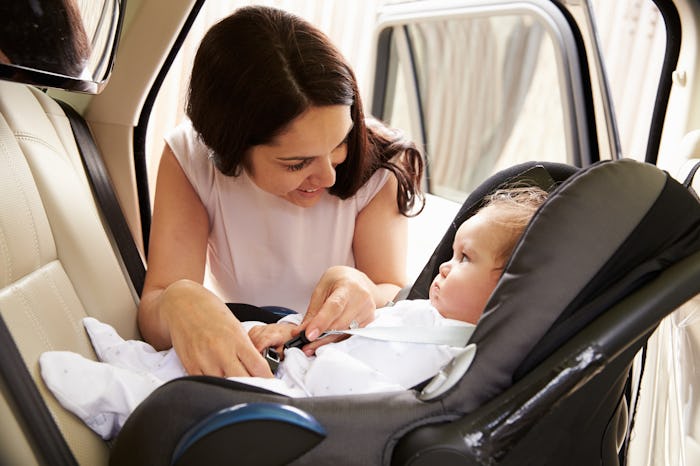Life
5 Diagrams Of Car Seat Strap Placement That Will Make You So Much Less Confused
It's no secret that car seats are incredibly important when it comes to keeping kids safe in a vehicle. But parents have a million things to think about, and sometimes things like car seat recalls throw a wrench into the plans of even the most attentive of caregivers. Luckily, there are lots of diagrams of car seat strap placement examples available from reputable organizations that any parent or caregiver can check out. These examples show exactly how your kid's car seat harness straps and tether straps should be placed when they ride along with you on errands, or when they're going to school, or any number of other activities that may necessitate having a child safely secured in the back seat.
Harness straps are used to position a child inside the car seat, according to the Automotive Safety Program at the Indiana University School of Medicine. They're the more obvious straps on the seat, and the ones you're probably used to seeing adjusted in most car seat guides.
Tether straps, on the other hand, are on the top of a child's car seat, and have a hook on the end to connect it to the tether anchor inside the vehicle, according to The Car Seat Lady. These straps are used for forward-facing car seats. Both harness straps and tether straps can be important for parents to use to make their child's car seat as safe as possible.
No matter if a child is using a forward-facing or rear-facing car seat, car seat strap placement is a huge part of keeping kids safe whenever they're in the car. A problem with a car seat in the event of a crash is something no parent wants to think about, so it's best to be sure that car seats — and the children in them — are as secure as possible in the first place.
So let's take a look at a few diagrams that depict the proper placement of car seat tether strap and harness straps.
American Academy Of Pediatrics
This diagram from the American Academy of Pediatrics shows where you should attach the tether strap on your child's car seat. Sixty-four percent of parents and caregivers who attended a Safe Kids car safety event did not use the tether, according to Safe Kids Worldwide and The Chicago Tribune. But it helps to keep a forward-facing car seat from tipping forward in the event of a crash, so it's extremely important.
Centers For Disease Control And Prevention
The CDC has a ton of different images and diagrams about how to use a harness strap on a car seat correctly. The placement of harness straps depends on the type of car seat — rear and forward-facing, rear-facing, or forward-facing car seats. The image above is for a rear and forward-facing seat, and the two below are for the other two types.
Here's rear-facing:
And here's the CDC's guide for a forward-facing car seat:
National Highway Traffic Safety Administration
This image from the NHTSA also demonstrates where the tether strap should go on a forward-facing car seat. It's very similar to the one provided by the AAP, with a little more information for readers.
These are just a few of the diagrams out there for parents looking for information on car seat strap placement, for both harness straps and tether straps. There are also lots of videos on the web about this topic — provided by agencies like the NHTSA, or on YouTube (though an official site like the NHTSA is your best bet, just to be really sure). Some YouTube videos set out to explain how to secure a baby in a car seat, and others are specifically about using tethers with a car seat.
But if you're still not positive your car seat straps are placed correctly, you can also get your car seat inspected at a location near you. Because when it comes to being sure you're using a car seat and all its parts correctly, it's better to be safe than sorry.
Watch Romper's new video series, Romper's Doula Diaries:
Check out the entire Romper's Doula Diaries series and other videos on Facebook and the Bustle app across Apple TV, Roku, and Amazon Fire TV.
